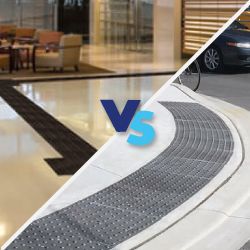









When it comes to accessibility, one size does not fit all. As experts in tactile solutions, we at Tactile Solution Canada understand the unique demands various indoor and outdoor applications place on navigational aids. This comprehensive guide delves deeper into choosing code-compliant tactile products optimized for their intended settings.
Indoors or outdoors, the overarching goal remains the same - fostering safe, intuitive accessibility for all. Nevertheless, mother nature and demanding foot traffic take their toll over time if not properly addressed. Outdoor elements ravage while indoor interference abounds. Let's explore strategic considerations for empowering accessibility sustainably through appropriate specifications.
While safety remains paramount indoors, wayfinding tactile solutions must complement interior aesthetics over extended lifecycles:
Style: Contemporary tiles integrate tactility seamlessly with flooring styles spanning decades of trends.
Material: Porcelain and stainless steel suit the elegance of offices and retail without appearing "institutional."
Colors: Neutral greys and blacks accent interiors subtly versus the signature safety yellow of exteriors.
Longevity: Hard-wearing polymer composites and rubber withstand foot traffic without visible wear for 15+ years.
Elan porcelain tactiles and rubber-based Eon tiles maintain the dignity of design matched with enduring functionality indoors.
Specialist indoor applications necessitate solutions optimized accordingly:
Stairs: Anti-slip Ecoglo stair nosings paired with visual/tactile truncated domes at landings identifiers safely guide stair ascent/descent in any lighting condition.
Signage: Photoluminescent exit signs and tactile lettering enable wayfinding/schedule accessibility for those with low vision or blindness.
Transit: Heavy-duty metal tiles withstand transit facility footfall intensity without damage.
Lobbies: Porcelain Elan tiles suit contemporary commercial interior aesthetics alongside code compliance.
Proper care in product selection optimizes universal accessibility sustainably.
Areas prone to puddle spills demand moisture resistance for longevity:
Porcelain Tile: Nonporous glazed surfaces repel water and exempt sealing requirements of other materials. Tolerates intermittent flooding/pooling.
Stainless Steel: Naturally resistant to moisture infiltration or deterioration without applied sealants/coatings.
Always follow manufacturer cleaning/maintenance guides matching individual product specifications.
For indoor spaces, these are some ideal code-compliant tactile systems:
Elan Tile porcelain tactile suits indoor applications with aesthetic needs. Products include:
Elan Porcelain Attention Domes: Warning indicators about potential hazards. Color contrasted for high visibility.
Elan Porcelain Wayfinding Bars: Visual and tactile arrows for path navigation. Available in different sizes.
Access Tile offers indoor solutions like:
Single Embedded Domes/Bars: Individual tactile domes or bars drilled into existing floors. No demolition is needed.
Surface-Applied Tactile Tiles: Polymer tiles applied on floors with adhesive. Easy to install and replace.
Fire-Rated Tactile Tiles: Meets fire code for stairs, lobbies, and corridors. Compulsory in buildings with more than 7 floors.
Eon Tile flexible rubber tactile suits a variety of indoor applications:
Surface-Applied Attention Domes: Alert pedestrians about upcoming drop-offs or hazards through texture.
Surface-Applied Wayfinding Bars: Provides directional cues to guide users to destinations.
Here are some top compliant tactile systems available in Canada for outdoor settings:
Armor Tile offers durable ADA, CSA, ISO, and OBC-compliant tactile solutions for outdoor spaces. Key products include:
Cast-In-Place Concrete Tiles: Embedded in fresh concrete for pedestrian crossings, plazas, etc. Highly durable and withstands heavy loads.
Surface-Applied Polymer Tiles: Applied on existing surfaces using adhesive. Ideal for retrofit projects. Available in standard and fire-rated options.
Replaceable Metal Tiles: Interlocking metal tiles installed on compacted gravel or hard surfaces for pedestrian routes.
This robust tactile system suits high-traffic outdoor applications. Products include:
Cast Iron Tiles: Heavy-duty cast iron tiles installed in concrete for high footfall areas. Withstand snow plows and construction vehicles.
Premier metal Tiles: Cast iron tiles with unique designs and patterns for aesthetic appeal. Ensure safety with style.
Stainless Steel Plates: Single stainless-steel plates installed into concrete. Optionally available with decorative patterns.
Access Tile offers lightweight polymer-based systems. Products suitable for outdoors:
Cast-In-Place Tactile Tiles: Lightweight tiles installed in fresh concrete. Non-slip textures enhance traction.
Surface-Applied Tactile Tiles: Applied on existing surfaces with adhesive. Ideal for renovation projects.
Selecting optimized materials outlasts standards, minimizing replacements:
Outdoors:
Concrete > 15 years apx
Cast Aluminum > 20 years apx
Cast Iron > 20 years apx
Indoors:
Porcelain > 20 years apx
Stainless Steel > 30 years apx
Rigid Polymer Composites > 25 years apx
Rubber > 15 years apx
Reputable manufacturers warrant quality, expertise, and solution lifecycles through ongoing support.
Application methods influence lifespan:
Surface-Applied Indoors: Bonding strength maintains tiles over time versus demountable options.
Cast Installations: Integral installation shields tiles from vandalism and abrasion versus surface bonding susceptible to degrading.
New Construction: Casting tiles within structural concrete maximizes the longevity of new builds.
Renovations: Surface application retrofits accessibility onto existing structures cost-effectively vs demolition.
Understanding each product/substrate compatibility guards against premature failures from improper installation.
Periodic inspection and basic cleaning uphold accessibility standards:
Inspect Quarterly: Note degrading slip-resistance and truncation reduction requiring refurbishment.
Sweep Weekly: Avoid accumulation, obscuring textures, and staining finishes.
Spot-Clean: An annual deeper cleaning restores a like-new appearance without damage.
Replace as Needed: Proactively replace approaching end-of-service-life indicators under warranties.
Contractors: Available for specialized needs like restoration and preventative replacements.
Diligent care safeguards user safety and building liability long-term.
Does this help clarify critical variables for outdoor versus indoor tactile suitability? Connect with our experts regarding questions on your project-specific needs. Partnerships promoting accessibility serve all communities graciously.
A: While outdoor tiles demand more robust materials, basic cleaning/inspection intervals align indoors/outdoors for general maintenance of code-compliant tactile.
A: Typically, no, as outdoor tiles focus on weather resistance over aesthetics/comfort. Some rigid composite outdoor tiles may suffice indoors if matching load ratings. Consult manufacturers.
A: Quality polymer composite tactile tiles last 15-20 years indoors on average with proper installation and maintenance. High-use zones may require refreshing every 10+ years.
A: Recommended intervals are monthly for heavy-use areas, quarterly for average traffic zones, or annually for low-usage spaces to catch needs early for remediation.
